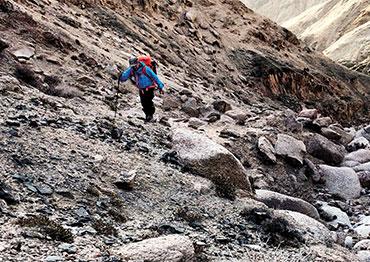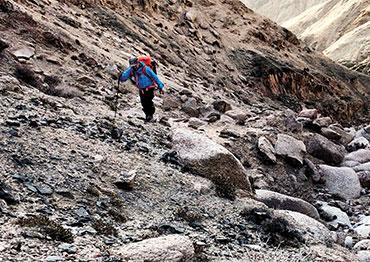Finding the Lenghu site was not a planned outcome. In 2009, the National Astronomical Observatories of China Stellar Observations Network Group (SONG) was ordered to build a telescope. Deng Licai and his team started looking for a site, taking five years to choose the location for the Purple Mountain Observatory’s observation station in Delingha in Haixi Mongol and Tibetan Autonomous Prefecture, Qinghai Province. By 2013, a one-meter telescope was in operation. But by 2017, as local urbanization sped up, light pollution had increased 1,000-fold compared to 2013, affecting night clarity and observations.
That same year, officials from Lenghu, which means “cold lake,” also in Haixi Prefecture, approached Deng to talk about the high-quality dark sky environment of Lenghu and the nearby Yadan National Geological Park, known for its wind-eroded rocks. The officials wanted to push the idea of Lenghu becoming an observatory site.
Astronomers categorize observation devices built on the ground based on wave band, radio and optical telescopes. Optical telescopes work in the visible light band – the larger the caliber, the better. Radio telescopes work at the long end of the electromagnetic spectrum, so they are not restricted by clouds or night.
The Five-hundred-meter Aperture Spherical Radio Telescope (FAST), which took five years to construct and opened in 2016 in Pingtang County, Guizhou Province, is the world’s largest single-dish radio telescope, with a receiving area equivalent to 30 football fields. Chang Jin, head of the National Astronomical Observatories, told NewsChina there is still a sizable gap between China and the world. There are already 10 optical telescopes of 10 meters elsewhere, while China’s largest general optical telescope is only 2.4 meters. The Large Sky Area Multi-object Fiber Spectroscopic Telescope (LAMOST), or Guo Shoujing Telescope in Xinglong County, Chengde in Hebei Province, though four to six meters in caliber, is a spectroscopic telescope, which uses radio waves, ultraviolet light, X-rays, infrared and visible light, but it cannot make imaging observations. Although funding for large devices is possible in the future, Chang pointed out without a proper site, telescopes will not achieve their designed effect.
Deng, also lead author of the Nature article, told NewsChina that Europe attaches great importance to the development of astronomy, and in the 1960s, 16 countries came together to form the European Southern Sky Observatory (ESO) with observatories in Chile. In the 1980s, they started searching for observatory sites for the next generation, or 8-meter telescopes.
Both China’s first modern observatories, the Purple Mountain Observatory in Nanjing, capital of Jiangsu Province, and Xinglong Station in Hebei Province which is near the cities of Tianjin and Beijing, are now obscured by light and air pollution as they are close to major urban areas. This renders them unsuitable for new-generation telescopes with higher caliber and sensitivity requirements.
At the turn of the century, Chinese astronomers began looking for suitable observatory sites in high-altitude locations like the Qinghai-Tibet Plateau. In 2003, the National Astronomical Observatories launched the strategic astronomical site selection project in western China. In 2016, the National 12-meter Lunar-based Optical Telescope (LOT) project was approved and site selection began. There were three candidates, Ali in Tibet Autonomous Region and Daocheng in western Sichuan Province, both on the Qinghai-Tibet Plateau, and Muztagh Ata in Xinjiang Uygur Autonomous Region, on the Pamir Plateau. But none was picked.
According to Deng, Lenghu has more geographical advantages than the others. On the northwestern edge of the Qinghai-Tibet Plateau, it is at the junction of Gansu, Qinghai and Xinjiang, thus it is not too remote. “Land transport from the site to the local support base, Lenghu Town, and then to the developed areas of China by road and railway networks is convenient,” Deng said.
According to the Nature article, the nearest international airport, highway access and cargo railway stations of the tourist city of Dunhuang are within 250 kilometers. Lenghu Town sits only 2,700 meters above sea level and is 80 kilometers from the site, which provides comfortable conditions for a support base. This infrastructure enables good logistics for future activity. Climate records at three local weather stations for the past 30 years show average annual precipitation of around 18 millimeters, with over 3,500 hours of annual sunshine.
Deng said that in the late 1980s and the early 1990s, China conducted a general survey of resources on the Qinghai-Tibet Plateau, including evaluating whether it could build an observatory. Lenghu was excluded because of extensive areas of wind erosion and closeness to the Taklimakan Desert. Yet, Deng’s team found that the vertical distance between the Lenghu site and the windy Qaidam Basin was over 1,000 meters, making it difficult for dust from the desert basin to reach the top of the mountain. Even if there were a sandstorm at the foot of the mountain, the air at the summit would remain clear.
Lenghu used to be an important oil producer, and at its most prosperous had a population of 100,000. As the oil dried up in the 1980s, people left and only some 100 people live in the town today. In 2017, an official from Lenghu promised Deng that the government would designate the entire area as a dark sky reserve. He vowed Lenghu would regulate the use of light for local enterprises and municipal and household lighting to guarantee the long-term night-sky protection for the telescope. With potential threats to astronomical observations addressed, Deng and his team started searching for mountain peaks at an altitude of 4,200 to 4,500 meters. Finally, they chose Saishiteng summit at 4,200 meters.

 Old Version
Old Version

